Hard Facts About Soft Drinks
by Jodie Shield and Mary Mullen, RD MS
Sweetened Soft Drinks
The main ingredient in sweetened soft drinks is water; they are about 90 percent carbonated water. They provide essentially no key nutrients and are sweetened with either sugar or high-fructose corn syrup, which is a combination of fructose and dextrose (a sugar that comes from corn). There’s been a great debate as to whether high-fructose corn syrup may be the reason why obesity rates in the United States have skyrocketed, but there is not enough scientific evidence to say that this sweetener changes metabolism, increases body fat, or boosts appetite. Many companies are removing high fructose corn syrup from their products, but the key to reaching a healthy weight is to trim calories—cut back on all types of added sugar.
Soft drink flavors come from artificial and natural flavors. Acids such as citric acid and phosphoric acid give a tart taste and act as preservatives. Coloring might also be added. Many soft drinks also contain caffeine. While caffeine is not necessarily harmful, it is a stimulant that can affect kids’ alertness and sleep patterns; make them feel anxious, jittery, or dizzy; or cause headaches. Unfortunately, the amount of caffeine is not listed on labels or in the Nutrition Facts, but most caffeine-free soft drinks say so on the label.
If your child or teen drinks sweetened soft drinks, consider these Think Before You Drink tips:
- Cut down the quantity over time. Each week, have your kid cut back until he or she reaches the goal of drinking one serving or less a day. And, no, a 64-ounce cup is not a serving! The daily limit should be no more than 8 to 12 ounces, or—better yet—none at all.
- Diet sodas are a better alternative than regular sodas, but water is the best way to quench thirst.
- Serve water or low-fat or fat-free milk at meals instead of soft drinks.






